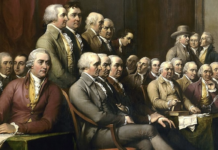![]()
As a new member of the Philodemic Society, I have spent hours going over the history and mission of our storied organization. As I read over this history and pondered the values that the organization is rooted in, I became utterly surprised at the uproar caused by the removal of portraits in the Philodemic Hall among other renovations. If you believe in the society’s original purpose of “Eloquence in Defense of Liberty” and that the original intent of the society is to be “a forum for developing skills needed to watch over and defend the nation,” then you must support the reimagination of the Philodemic Hall.
When I first entered the Philodemic Hall this fall, one of the first things I noticed was the portraits surrounding the hall. At first glance, the portraits seem harmless–but upon reading the true stories of the men whose faces lined the walls, the values of some of these men seem to directly contradict the very ones that the Society seeks to promote. For example, John C. Calhoun, an ardent pro-slavery Senator whose beliefs strongly influenced the confederacy, was framed on the wall. Furthermore, Stephen R. Mallory, another one of the men in the portraits, was the former confederate secretary of the Navy. If our society truly believes in its most sacred value of defending liberty, then these are the portraits we must remove. How can someone who supported the heinous practices of slavery and segregation be eloquent in the “Defense of Liberty” if they clearly do not believe in Liberty.
In addition, the portraits that line the walls also include men who contradict the very purpose of the society. When it came time for a rigorous defense of our nation, many of these men lining the walls failed to follow through. Instead, they betrayed their core mission and turned against the very nation they were entrusted to safeguard. No society should put on a pedestal those who refuse to live up to the values of their organization; this would be a betrayal of not only the entity’s original mission but also the member body as a whole.
While some may argue that we should honor the past of the society and that the Philodemic hall is a “sacred space,” I argue that the hall can not be a sacred space if we betray the values the society has stood for. No church would ever add a portrait glorifying Nero or Plutarco Elías Calles to its walls. These are men who actively stood against the values of the organization in their lives. For the same reason no church would include these men in a sacred space, the Philodemic hall mustn’t include those who stood against liberty and the Union.
So why were these portraits included in the Philodemic hall in the first place? The truth is that the Philodemic Society and Georgetown has had an embattled history. As a university with many Southerners, the legacy of the civil war, slavery, and the reconciliation afterwards, the Philodemic Society made decisions off of the times. They believed that a balanced array of portraits in the room would allow for the healing and rekindling of friendships.
While I heavily value the importance of reconciliation, we are no longer in the post-bellum. Brothers have not taken up arms against each other for 150 years. We are instead in a period of time where we seek to improve the strained relations between the races of individuals. Today, the portraits hanging in the hall now serve as merely a contradiction to the values of our society. They stand as an offense to those who value the ideals of liberty and watching over our nation. While we should recognize the troubled history of our beloved Society, providing a pedestal to these figures is not the way forward.
Even still, some argue that the Philodemic hall’s present design is intended to show the victory of the abolitionists. For example, one opinion against the reimagination against Philodemic hall claims that “ultimately, the progression of the names on the ceiling tells the story of the triumph of the abolitionist and Unionist side in the Civil War, which birthed a better and freer America.” It is clear that this was not the intent of the design of the Philodemic hall. Pictures of confederates were intermixed with those of abolitionists. It was clearly not the intention of those who designed the hall to show the triumph of the Abolitionists over slavers.
If there is a concern that eliminating the problematic figures from Philodemic hall would decrease awareness around the issue of slavery, those concerns are well-founded. I myself am concerned about the erasure of history, however, there are better ways to acknowledge these historical flaws. For example, the Philodemic could installl a small exhibit describing the historical legacy in another room on campus.
One important question remains: if these pictures are to be removed from the hall, what figures, who actually upheld the values of the Philodemic Society, would make for suitable replacements? The new portraits should be of men and women who have safeguarded liberty, watching over and defending our nation. Some figures I would like to propose include Martin Luther King Jr., Frederick Douglas, Ronald Reagan, Jane Adams and Philodemic Alumni Antonin Scalia. All of these speakers sought to defend or expand liberty and watched over those who constitute the American nation.
In conclusion, the importance of tradition to Georgetown’s oldest club is something that must be preserved. However, we can include this tradition while creating an inclusive space which serves to represent the values of the society.












